Martinndungu1986
On this page, you find all documents, package deals, and flashcards offered by seller martinndungu1986.
- 630
- 0
- 20
Community
- Followers
- Following
650 items
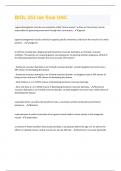
BIOL 253 lab final UNC questions with accurate answers
(agonist/antagonist) muscles are sometimes called "prime movers" as they are the primary muscle responsible for generating movement through their contraction. - agonist (agonist/antagonist) muscles control (or oppose) specific movement, and return the muscle to its initial position. - antagonist A child has recently been diagnosed with Duchenne muscular dystrophy, an X-linked, recessive condition. The parents are receiving genetic counseling prior to planning another pregnancy. Which of ...
- Exam (elaborations)
- • 16 pages •
(agonist/antagonist) muscles are sometimes called "prime movers" as they are the primary muscle responsible for generating movement through their contraction. - agonist (agonist/antagonist) muscles control (or oppose) specific movement, and return the muscle to its initial position. - antagonist A child has recently been diagnosed with Duchenne muscular dystrophy, an X-linked, recessive condition. The parents are receiving genetic counseling prior to planning another pregnancy. Which of ...
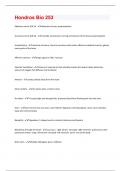
Hondros Bio 253 questions and answers
Abducens nerve (CN VI) - abduction of eye, proprioception Accessory nerve (CN XI) - shoulder movements, turning movements of the head, proprioception Acetylcholine - chemical structure, found in junctions with motor effectors (skeletal muscles, glands, many parts of the brain Afferent neurons - Brings signal to CNS, *sensory Alveolar Ventilation - Volume of inspired air that actually reaches the alveoli, helps determine amount of oxygen that diffuses into the blood Arteries - conduct bloo...
- Exam (elaborations)
- • 7 pages •
Abducens nerve (CN VI) - abduction of eye, proprioception Accessory nerve (CN XI) - shoulder movements, turning movements of the head, proprioception Acetylcholine - chemical structure, found in junctions with motor effectors (skeletal muscles, glands, many parts of the brain Afferent neurons - Brings signal to CNS, *sensory Alveolar Ventilation - Volume of inspired air that actually reaches the alveoli, helps determine amount of oxygen that diffuses into the blood Arteries - conduct bloo...
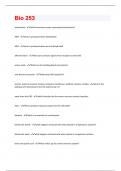
Bio 253 questions and verified answers
actocholine - which hormone causes contraction/constriction? ADH - what is produced when dehydrated ADH - what is produced when we are dehydrated afferent fibers - what carry sensory signals from receptors to the CNS amino acids - What are the building blocks of proteins? anti-diuretic hormone - What does ADH stand for? auricle, external acoustic meatus, tympanic membrane, auditory ossicles, cochlea - what is the pathway of transmission from the external ear in? away form the CNS - which...
- Exam (elaborations)
- • 5 pages •
actocholine - which hormone causes contraction/constriction? ADH - what is produced when dehydrated ADH - what is produced when we are dehydrated afferent fibers - what carry sensory signals from receptors to the CNS amino acids - What are the building blocks of proteins? anti-diuretic hormone - What does ADH stand for? auricle, external acoustic meatus, tympanic membrane, auditory ossicles, cochlea - what is the pathway of transmission from the external ear in? away form the CNS - which...
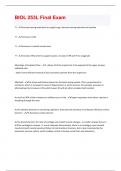
BIOL 253L Final Exam Questions with Answers
?? - Increase during inspiration to supply lungs, decrease during expiration to baseline ?? - increase in CO2 ?? - increase in smooth muscle tone ?? - increases HR and CO to supply muscles, increase in RR and TV to oxygenate Advantage of turbulent flow: - - allows all of the inspired air to be exposed to the upper airways epithelial cells - allows more efficient removal of dust and other particles from the inspired air Afterload - the active wall tension placed on the heart during systole...
- Exam (elaborations)
- • 13 pages •
?? - Increase during inspiration to supply lungs, decrease during expiration to baseline ?? - increase in CO2 ?? - increase in smooth muscle tone ?? - increases HR and CO to supply muscles, increase in RR and TV to oxygenate Advantage of turbulent flow: - - allows all of the inspired air to be exposed to the upper airways epithelial cells - allows more efficient removal of dust and other particles from the inspired air Afterload - the active wall tension placed on the heart during systole...
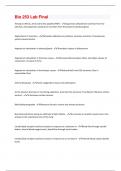
Bio 253 Lab Final Exam Questions and Verified Answers
Among its effects, atrial natriuretic peptide (ANP): - Suppresses aldosterone secretion from the adrenals, and suppresses vasopressin secretion from the posterior pituitary gland. Angiontensin II Functions - Stimulates aldosterone synthesis, increases secretion of vasopressin, potent vasoconstrictor Angiotensin stimulation in adrenal glands - Stimulates release of aldosterone Angiotensin stimulation in the brain causes - Decreased baroreceptor reflex, stimulates release of vasopressin, inc...
- Exam (elaborations)
- • 19 pages •
Among its effects, atrial natriuretic peptide (ANP): - Suppresses aldosterone secretion from the adrenals, and suppresses vasopressin secretion from the posterior pituitary gland. Angiontensin II Functions - Stimulates aldosterone synthesis, increases secretion of vasopressin, potent vasoconstrictor Angiotensin stimulation in adrenal glands - Stimulates release of aldosterone Angiotensin stimulation in the brain causes - Decreased baroreceptor reflex, stimulates release of vasopressin, inc...
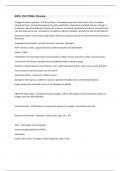
BIOL 253 FINAL Review Questions and Verified Answers
3 stages of stress response - Alarm Phase - immediate response to short term crisis, increased mental alertness, increased energy use by cells, mobilization of glycobon and lipid reserves, change in circulation, decreased digestive activity and urination, increased sweat gland secretion, increased heart rate and respriatory rate - stimulation sympathetic-adrenal medualla -epinephrine and noreeinephrine Resistance Phase- if stress lasts longer than a few hours Glutacocoticords are the dominan...
- Exam (elaborations)
- • 14 pages •
3 stages of stress response - Alarm Phase - immediate response to short term crisis, increased mental alertness, increased energy use by cells, mobilization of glycobon and lipid reserves, change in circulation, decreased digestive activity and urination, increased sweat gland secretion, increased heart rate and respriatory rate - stimulation sympathetic-adrenal medualla -epinephrine and noreeinephrine Resistance Phase- if stress lasts longer than a few hours Glutacocoticords are the dominan...
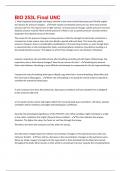
BIO 253L Final UNC questions and answers
1. What happened during light and heavy exercise to the mean arterial blood pressure? Briefly explain the reasons for pressure changes. - If both systolic and diastolic pressures rise, then mean arterial pressure will rise. This may be seen in light exercise. In heavy exercise though, systolic pressure rises and diastolic pressure may fall. Mean arterial pressure is likely to rise as systolic pressure increases tend to be greater than diastolic pressure decreases. The reason for the pressur...
- Exam (elaborations)
- • 4 pages •
1. What happened during light and heavy exercise to the mean arterial blood pressure? Briefly explain the reasons for pressure changes. - If both systolic and diastolic pressures rise, then mean arterial pressure will rise. This may be seen in light exercise. In heavy exercise though, systolic pressure rises and diastolic pressure may fall. Mean arterial pressure is likely to rise as systolic pressure increases tend to be greater than diastolic pressure decreases. The reason for the pressur...
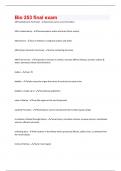
bio 253 final exam questions with verified answers
ADH (antidiuretic hormone) - prevents excess urine formation ADH is detected by - Osmoreceptors within the brain (thirst center) Aldosterone - act on kidneys to reabsorb sodium and water ANH (atrial natriuretic hormone) - urine containing hormone ANH from atrium - responds to increase in stretch, secretes ANH to kidneys, secretes sodium & water, decreases blood volume/stretch. babies - over 70 bladder - elastic muscular organ that stores & contracts to expel urine bladder is made up of -...
- Exam (elaborations)
- • 4 pages •
ADH (antidiuretic hormone) - prevents excess urine formation ADH is detected by - Osmoreceptors within the brain (thirst center) Aldosterone - act on kidneys to reabsorb sodium and water ANH (atrial natriuretic hormone) - urine containing hormone ANH from atrium - responds to increase in stretch, secretes ANH to kidneys, secretes sodium & water, decreases blood volume/stretch. babies - over 70 bladder - elastic muscular organ that stores & contracts to expel urine bladder is made up of -...
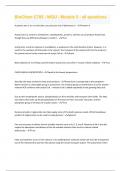
BioChem C785 - WGU - Module 5 - all questions and answers
A patient who is on a no-fat diet is at particular risk of deficiency in: - Vitamin A Acetyl-CoA is a central to metabolism. Carbohydrates, proteins, and fats can all produce Acetyl-CoA, though they use different pathways to make it. - True Acetyl-CoA, a central molecule in metabolism, is produced in the mitochondrial matrix. However, it is used for the synthesis of fatty acids in the cytosol. The transport of the acetyl-CoA from the matrix to the cytosol occurs by the conversion of acetyl-...
- Exam (elaborations)
- • 4 pages •
A patient who is on a no-fat diet is at particular risk of deficiency in: - Vitamin A Acetyl-CoA is a central to metabolism. Carbohydrates, proteins, and fats can all produce Acetyl-CoA, though they use different pathways to make it. - True Acetyl-CoA, a central molecule in metabolism, is produced in the mitochondrial matrix. However, it is used for the synthesis of fatty acids in the cytosol. The transport of the acetyl-CoA from the matrix to the cytosol occurs by the conversion of acetyl-...
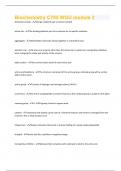
Biochemistry C785 WGU module 2 questions with accurate answers
Activation energy - Energy needed to get a reaction started active site - The binding platform part of an enzyme for its specific substrate. aggreggate - Hydrophobic molecules Clump together in a disorderly way allosteric site - A site on an enzyme other than the active site, to which non competitive inhibitors bind, changing the shape and activity of the enzyme. alpha carbon - the central carbon atom of each amino acid amino acid backbone - The structure comprised of the amino group, carb...
- Exam (elaborations)
- • 4 pages •
Activation energy - Energy needed to get a reaction started active site - The binding platform part of an enzyme for its specific substrate. aggreggate - Hydrophobic molecules Clump together in a disorderly way allosteric site - A site on an enzyme other than the active site, to which non competitive inhibitors bind, changing the shape and activity of the enzyme. alpha carbon - the central carbon atom of each amino acid amino acid backbone - The structure comprised of the amino group, carb...
